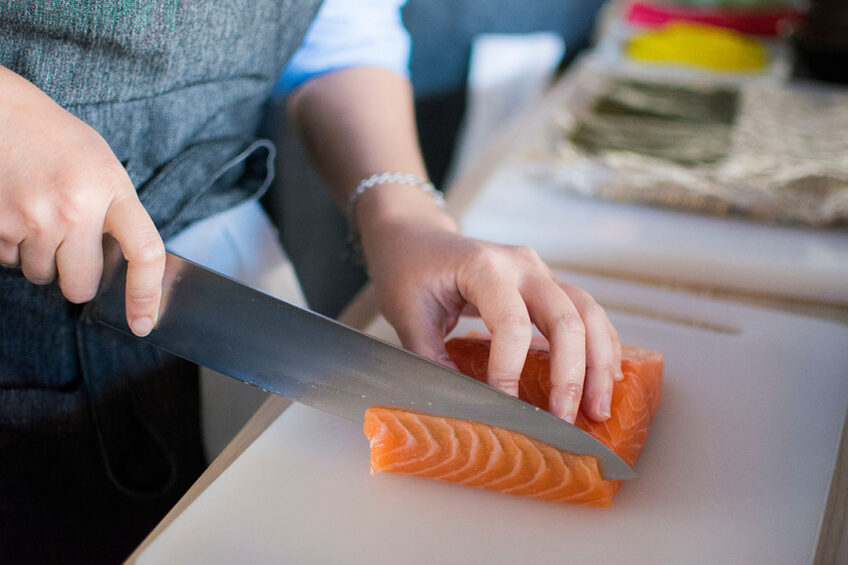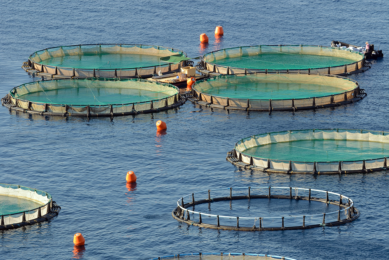Astaxanthin: Taking aquaculture full circle

A circular economy holds great potential to minimise the use of limited resources and reduce waste formation by the creation of closed-loop systems. In aquaculture, a new study published in the journal Molecules elaborates on how aquaculture side-streams could be recycled back into aquaculture as the valuable feed ingredient ‘astaxanthin’.
Growing demand for fish
Several reports show that consumer demand for seafood is rising as the world population grows and healthier diets are becoming more important. This tremendous demand for fish cannot be met by fishery alone. Recirculating aquaculture systems (RAS) present a promising alternative to traditional cultivation systems as they greatly reduce land and water requirements while offering year-round fish growth and providing high environmental control. RAS have great opportunities for waste management and nutrient recycling as their effluents are mainly composed of settleable and dissolved nutrients from faeces and unconsumed fish feed, which are removed to re-use the water for the fish tanks. Via settling of the backwash water, a sludge phase containing most of the settleable wastes and an aqueous side-stream can be obtained for other uses.
Carotenoids
On the other hand, one of the most important quality criteria of aquaculture-bred fish, such as salmon, rainbow trout and crustaceans is the degree of freshness and shell pigmentation, as it dictates market value. As fish and other aquatic animals are unable to synthesise essential carotenoids in the body, carotenoids are mixed into the feed of farmed fish and crustaceans; the red, cyclic C40 carotenoid ‘astaxanthin’ is the major carotenoid used in aquatic feeds. Currently, astaxanthin’s synthetic production dominates the market. However, there is a growing trend towards naturally sourced carotenoids due to consumer demand and new regulations. This opens the market for alternative production technologies.
In the current study, researchers at Bielefeld University in Germany used aquaculture side-streams to produce carotenoids, mainly the fish feed ingredient astaxanthin. In their study, an aquaculture side-stream from a salmon farm was utilised as a component of the growth medium to support carotenoid production by the bacterium Corynebacterium glutamicum (C. glutamicum).
Nutritional composition of the aquaculture side-stream
In this study, the liquid phase of an aquaculture side-stream from a Norwegian salmon farm was analysed in terms of its physical parameters and nutrient composition to get insights about which components of the ‘standard minimal growth medium’ of C. glutamicum might be substituted by the aquaculture side-stream. The aquaculture side-stream had a pH of 5.5 and a dry matter fraction of 16.5 g/ L. Nutrient analysis of the aquaculture side-stream showed that nitrogen (8 g/ L) is the major macronutrient, followed by potassium (3 g /L K and 3 g /L K2O) and sulphate (2 g /L). Furthermore, elemental sulphur, phosphorus, calcium, zinc and boron were detected. The presence of proteinogenic and non-proteinogenic amino acids and chelating agents such as cadaverine were also detected.
Our proof-of-principle example for the production of the fish feed supplement astaxanthin from aquaculture side-stream holds the potential to contribute to the establishment of a circular economy in aquaculture.
Growth of Corynebacterium glutamicum in aquaculture side-streams
To use the aquaculture sidestream as a growth medium component, it was pre-processed; centrifugation and subsequent sterile filtration were applied to obtain the aquaculture side-stream as a growth medium for Corynebacterium glutamicum.
To elucidate which components of the standard growth medium could be replaced by the side-stream medium, each component of the standard growth medium composition was substituted by 20% side-stream medium; replacement of the components of the standard growth medium (CaCl2, MgSO4, biotin, protocatechuic acid, or trace elements) resulted in comparable biomass formation and growth rates, which indicated that addition of 20% aquaculture side-stream medium is sufficient to replace these components of a standard growth medium for Corynebacterium glutamicum. In addition, the growth of C. glutamicum was supported by aquaculture side-stream as the sole medium component, although at a lower level compared to the standard medium.
Astaxanthin production in an aquaculture side-stream-supplemented medium
Taken together, the use of an aquaculture side-stream medium in the micro-cultivation (small scale) of carotenoids led to a positive effect on carotenoid production by C. glutamicum. Supplementation of 20% aquaculture side-stream to the standard medium improved the production of most carotenoids, particularly astaxanthin. The researchers highlighted the fact that the iron-sulphur clusters containing enzymes of carotenoid biosynthesis have a high demand for sulphur and iron to be provided by the medium. “In this respect, it is noteworthy that supplementation with aquaculture side-stream (containing 1 g/L sulphur and 2 g/L SO4) increased sulphur availability,” they said. They added that the differences in carotenoid production observed with different growth media suggests that production of each carotenoid may be improved by optimising the (trace) element composition of the growth medium. This warrants further research.
After having shown that astaxanthin production by C. glutamicum was enhanced by the addition of 20% aquaculture side-stream to the standard medium in micro-cultivation, lab-scale bioreactors were used to test if this improvement was stable on a larger scale. The results showed that astaxanthin production is considerably improved in bioreactor batch cultivation, indicating that the beneficial effect of aquaculture side-stream supplementation is transferable to larger scales under defined bioreactor conditions.
Concluding remarks
The current study confirms the growth of bacterium Corynebacterium glutamicum in an aquaculture side-stream medium and the production of carotenoids in both a small-scale and large-scale facility. According to the researchers, their study is the first to demonstrate the production of bacterial astaxanthin from aquaculture side-streams. However, they highlighted that since the aquaculture side-stream is a complex source of macro- and micro-elements, future research could focus more on which nutritional components support the production of carotenoids.
They concluded: “Our proof-of-principle example for the production of the fish feed supplement astaxanthin from aquaculture side-stream holds the potential to contribute to the establishment of a circular economy in aquaculture.”
Based on an original article by Ina Schmitt, Florian Meyer, Irene Krahn, Nadja A. Henke, Petra Peters-Wendisch and Volker F. Wendisch. 2023. From aquaculture to aquaculture: production of the fish feed additive astaxanthin by corynebacterium glutamicum using aquaculture sidestream. Molecules, 28: 1996.











